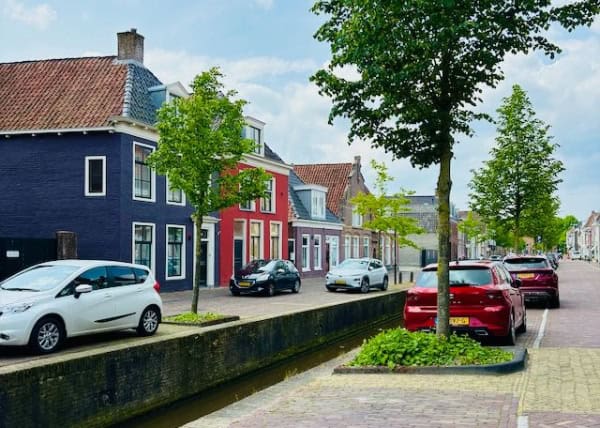In the Netherlands, Franeker is one of 11 historical cities of the northern province of Friesland. 1,200 years ago, it was a stronghold for the Carolingians, (the family of Charlemagne & co, remember?) Today, it is the kind of place where you park the car along the canal, hoping you’re not so close to the edge, you’ll step right into the water when you get out. Or is that just me?
Mine is the red one in front. Not taking any chances.
Across the cobbled street from Franeker’s imposing former city hall…
… is a fairly unassuming building, a typical Dutch canal side house, one of several along the street.
Inside this building, is something remarkable: a planetarium! Or rather, an 18th century model of the solar system – on a ceiling!
I love – and very much relate to – the curiosity that must have spurred this on. I also love – but cannot claim I relate to – the ingenuity behind this astronomical feat.
Eise Eisinga, however, had that ingenuity. A wool comber by trade and astronomer by passion, he created a moving, mechanical model of the solar system on the ceiling of his bedroom/sitting room.
Curiosity and reason challenging superstition and ignorance
Now, recreating the solar system requires considerable skill. What would drive an 18th century wool comber to go to all the trouble of teaching himself complex mathematics and mechanics and actually build a model of the solar system?
Well, in 1774, an unusual planetary alignment led to church folks and other conspiracy theorists predicting cosmic chaos. Earth will be pulled out of its orbit, they said. You won’t be surprised to hear that this led to widespread panic. Nothing is new in the world, is it?
But Eisinga would have none of it. Unscientific nonsense, he said, and at the tender young age of 30, he proceeded to build the model to educate the public about how the solar system really worked, and dispel fear.
The Eisinga Planetarium is a symbol of the Age of Enlightenment, a period in time when curiosity and reason began to challenge superstition and ignorance.
Here’s Eise Eisinga, possibly pondering the planets
The positions of the planets are accurate, the distance between them is at scale, and they orbit the sun in real-time. That’s some serious precision right there. And durability. It has been operating non-stop for 250 years!
Only 6 planets?
If you take a close look at the solar system here, you’ll see the sun, the moon and six planets – Mercury, Venus, Earth, Mars, Jupiter, and Saturn.
But… wait a minute! Six planets? What happened to the other two?
Well, Eisinga did not know about them. Neither did anyone else in 1774. Uranus was first discovered in 1781 and Neptune as late as 1846. Just as well perhaps, since the solar system fills the whole ceiling as it is. Uranus and Neptune simply would not have fit in this little room.
Did you notice the back wall?
Sitting room, bedroom and planetarium – all in one
The machinery
Behind the scenes, or rather, above the scene, up a steep set of stairs (we’re in a Dutch canal house, remember)…
… is the machinery that drives the model of the solar system:
The design is ingeniously simple and effective. Eisinga used the principles of clockwork. Everything – planets, pointers and clocks – is run by a vast system of wooden disks with ca. 6,000 wrought iron pins acting as cogs. A pendulum clock with a single weight, swinging 80 times/minute, controls the whole mechanism, regulating how fast the machinery turns. Eight weights connected to the main axles, provide the power to turn it. And so the planets continue their dance in the heavens, uninterrupted to this day.
Space: The interactive exhibits
The Eisinga Planetarium is a combination of a museum and an educational centre. In the interactive exhibits section called Space, you can learn how a telescope works…
You can get the Earth moving and learn about eclipses…
And, if you dare, you can step on the scale to see how much you weigh around in the solar system.
Jean Paulus’ astronomical cabinet
Also, don’t miss this fabulous astronomical clockwork, created by French instrument maker Jean Paulus in the 1770s.
Beautiful, isn’t it?
Other fun stuff in Eisinga planetarium
An astrolabe, the oldest instrument known to determine the sun’s altitude, and from that we can determine date, time and degree of latitude. (Also, a somewhat distorted moi. What can I say…)
A 12-kg iron-nickel meteorite found in the Namib Desert
Views from the planetarium: the former city hall and scenes of everyday life on a Friday afternoon in May, in Franeker
Eisinga planetarium practicals
Franeker is ca 1h 15min from Amsterdam and AMS by car, across the very cool Afsluitsdijk causeway. The train from AMS to Franeker takes about 3 hours, with a couple of train changes.
In the planetarium, you can wander around on your own, amongst interactive displays and modern astronomical equipment. I recommend listening to the guide talking about the planetarium and Eisinga himself. Prices and opening hours are here. Look out for stargazing nights.
In the next building over, is the cosy Brasserie de Stadstuin.
Just outside the planetarium, on the main square, Stadstuin, the city’s famous son is remembered.
Eise Eisinga, set in stone
Parked along the canal on Eise Eisinga Street, and left Franeke all dry, I’m glad to say. Sorry for any inconvenience caused.
Eisinga Planetarium in Franeker is a UNESCO World Heritage site.
Here are more UNESCO World Heritage sites around the world.
Eisinga Planetarium: where curiosity and reason challenged superstition and ignorance is a post from Sophie’s World
